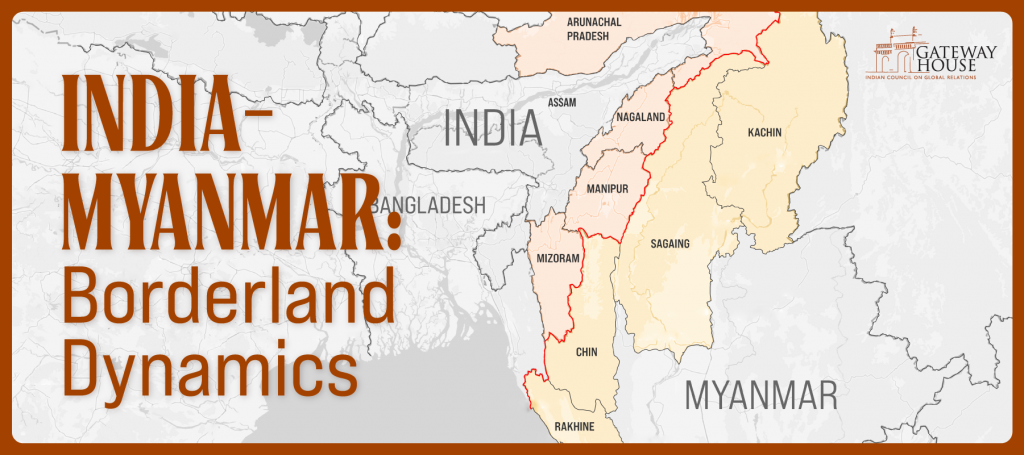
India’s Northeast is increasingly integrating with the rest of India due to a concerted push over the last decade to build infrastructure – both soft and hard. New roads aim to bring greater connectivity and market access[1] [2] and potential hope for local advancements. Asian countries like Japan[3] and South Korea have begun to invest in the seven sister states and have shown interest in recruiting international workforce from these states, many of which look to Asia as cousin cultures.[4] The region’s rich natural resources and good human development indicators[5] make it the geographical lynchpin for India’s connectivity to Southeast and East Asia.
The region, however, lags in economic growth, contributing only 2.8% to the country’s overall GDP, and the significant strides it made in human development have slowed down in recent years.[6] This is due to adverse environmental impacts and natural resource degradation; protracted insurgency in some areas; and lack of well-targeted and quality development efforts.[7]
Academic and political analysis of the region, though, often disassociates the Northeast’s context from that of India’s immediate eastern neighbour, Myanmar. Yet Northeast India and Myanmar are part of a contiguous river basin populated by communities with long-standing precolonial ethnic, cultural and commercial linkages.
India’s policy priorities for the Northeast are closely intertwined with its foreign policy objectives in Myanmar The domestic concerns in India’s northeast are a web of interlinked ethnic, political, economic and security issues that transcend national boundaries.
Taking the February 2021 coup in Myanmar as a starting point, Gateway House presents a timeline that highlights the cross-border dynamics in the four states on the Indo-Myanmar border: Arunachal Pradesh, Nagaland, Manipur, and Mizoram.
This unique timeline aims to help various stakeholders, from policymakers to corporate actors, researchers and academics, to think holistically about the cross-border dynamics impacting India’s Northeast, and to view its context from a “whole-of-system” based approach.
Read the digital timeline here.
Purvi Patel was the International Affairs Fellow, Council on Foreign Relations and former Visiting Fellow, Gateway House.
Charuta Ghadyalpatil is a Research Assistant, Gateway House.
Research Assistants: Aditya Shinde, Adithya Prakash, Vaishnavi Agarwal
Timeline developed and designed by How India Lives.
Map cover designed by Debarpan Das.
This infographic was exclusively designed for Gateway House: Indian Council on Global Relations. You can read more exclusive content here
Support our work here.
For permission to republish, please contact outreach@gatewayhouse.in
©Copyright 2024 Gateway House: Indian Council on Global Relations. All rights reserved. Any unauthorised copying or reproduction is strictly prohibited.
References
[1] Ministry for Development of Northeast Region, ‘Road Connectivity in North East Region,’ PIB, Dec 7, 2023, https://pib.gov.in/PressReleaseIframePage.aspx?PRID=1983585#:~:text=A%20total%20of%204950%20km,crore%20in%20North%20Eastern%20Region.
[2] Cecile Fruman, ‘In Northeast India, All Roads Lead to Greater Development,’ World Bank Blogs, March 1, 2023, https://blogs.worldbank.org/en/endpovertyinsouthasia/northeast-india-all-roads-lead-greater-development
[3] Ministry for Development of Northeast Region, ‘Japan to invest Rs 13,000 cr in Northeast,’ June 12, 2019, https://pib.gov.in/newsite/PrintRelease.aspx?relid=190376
[4] Northeast India: Republic of Korea- India: Special Strategic Partnership and the Way Forward, Asian Confluence Center, April 18, 2023, https://www.asianconfluence.org/pdf/1681785413Concept%20Note.pdf
[5] For Human Development Index and Gender Inequality Index, see Ankur Bhardwaj, ‘HDI: How States Fare in Human Development,’ Centre for Economic and Data Analysis, Ashoka University, June 14, 2021, https://ceda.ashoka.edu.in/hdi-how-states-fare-in-human-development/; ‘HUMAN DEVELOPMENT INDEX ACROSS INDIAN STATES: IS THE GLASS STILL HALF EMPTY?,’ State Bank of India, March 2019, https://sbi.co.in/documents/13958/14472/Ecowrap_20190308.pdf
[6] India – North East Rural Livelihoods Project (NERLP). The World Bank, July 2011. https://documents.worldbank.org/en/publication/documents-reports/documentdetail/875201468041662454/india-north-east-rural-livelihoods-project-nerlp; Cecile Fruman, ‘In Northeast India, All Roads Lead to Greater Development,’ World Bank Blogs, March 1, 2023, https://blogs.worldbank.org/en/endpovertyinsouthasia/northeast-india-all-roads-lead-greater-development; ‘HUMAN DEVELOPMENT INDEX ACROSS INDIAN STATES: IS THE GLASS STILL HALF EMPTY?,’ State Bank of India, March 2019, https://sbi.co.in/documents/13958/14472/Ecowrap_20190308.pdf
[7] World Bank North East Rural Livelihoods Project, 2011 Project Proposal, NERLP000draft0PID000July04.pdf (worldbank.org)


